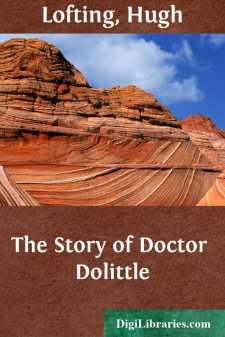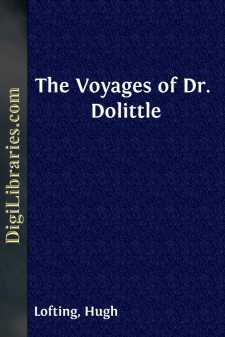Categories
- Antiques & Collectibles 13
- Architecture 36
- Art 48
- Bibles 22
- Biography & Autobiography 813
- Body, Mind & Spirit 142
- Business & Economics 28
- Children's Books 17
- Children's Fiction 14
- Computers 4
- Cooking 94
- Crafts & Hobbies 4
- Drama 346
- Education 46
- Family & Relationships 57
- Fiction 11829
- Games 19
- Gardening 17
- Health & Fitness 34
- History 1377
- House & Home 1
- Humor 147
- Juvenile Fiction 1873
- Juvenile Nonfiction 202
- Language Arts & Disciplines 88
- Law 16
- Literary Collections 686
- Literary Criticism 179
- Mathematics 13
- Medical 41
- Music 40
- Nature 179
- Non-Classifiable 1768
- Performing Arts 7
- Periodicals 1453
- Philosophy 64
- Photography 2
- Poetry 896
- Political Science 203
- Psychology 42
- Reference 154
- Religion 513
- Science 126
- Self-Help 84
- Social Science 81
- Sports & Recreation 34
- Study Aids 3
- Technology & Engineering 59
- Transportation 23
- Travel 463
- True Crime 29
The Story of Doctor Dolittle
by: Hugh Lofting
Categories:
Description:
Excerpt
There are some of us now reaching middle age who discover themselves to be lamenting the past in one respect if in none other, that there are no books written now for children comparable with those of thirty years ago. I say written FOR children because the new psychological business of writing ABOUT them as though they were small pills or hatched in some especially scientific method is extremely popular today. Writing for children rather than about them is very difficult as everybody who has tried it knows. It can only be done, I am convinced, by somebody having a great deal of the child in his own outlook and sensibilities. Such was the author of "The Little Duke" and "The Dove in the Eagle's Nest," such the author of "A Flatiron for a Farthing," and "The Story of a Short Life." Such, above all, the author of "Alice in Wonderland." Grownups imagine that they can do the trick by adopting baby language and talking down to their very critical audience. There never was a greater mistake. The imagination of the author must be a child's imagination and yet maturely consistent, so that the White Queen in "Alice," for instance, is seen just as a child would see her, but she continues always herself through all her distressing adventures. The supreme touch of the white rabbit pulling on his white gloves as he hastens is again absolutely the child's vision, but the white rabbit as guide and introducer of Alice's adventures belongs to mature grown insight.
Geniuses are rare and, without being at all an undue praiser of times past, one can say without hesitation that until the appearance of Hugh Lofting, the successor of Miss Yonge, Mrs. Ewing, Mrs. Gatty and Lewis Carroll had not appeared. I remember the delight with which some six months ago I picked up the first "Dolittle" book in the Hampshire bookshop at Smith College in Northampton. One of Mr. Lofting's pictures was quite enough for me. The picture that I lighted upon when I first opened the book was the one of the monkeys making a chain with their arms across the gulf. Then I looked further and discovered Bumpo reading fairy stories to himself. And then looked again and there was a picture of John Dolittle's house.
But pictures are not enough although most authors draw so badly that if one of them happens to have the genius for line that Mr. Lofting shows there must be, one feels, something in his writing as well. There is. You cannot read the first paragraph of the book, which begins in the right way "Once upon a time" without knowing that Mr. Lofting believes in his story quite as much as he expects you to. That is the first essential for a story teller. Then you discover as you read on that he has the right eye for the right detail. What child-inquiring mind could resist this intriguing sentence to be found on the second page of the book:
"Besides the gold-fish in the pond at the bottom of his garden, he had rabbits in the pantry, white mice in his piano, a squirrel in the linen closet and a hedgehog in the cellar."
And then when you read a little further you will discover that the Doctor is not merely a peg on whom to hang exciting and various adventures but that he is himself a man of original and lively character. He is a very kindly, generous man, and anyone who has ever written stories will know that it is much more difficult to make kindly, generous characters interesting than unkindly and mean ones. But Dolittle is interesting. It is not only that he is quaint but that he is wise and knows what he is about. The reader, however young, who meets him gets very soon a sense that if he were in trouble, not necessarily medical, he would go to Dolittle and ask his advice about it. Dolittle seems to extend his hand from the page and grasp that of his reader, and I can see him going down the centuries a kind of Pied Piper with thousands of children at his heels. But not only is he a darling and alive and credible but his creator has also managed to invest everybody else in the book with the same kind of life.
Now this business of giving life to animals, making them talk and behave like human beings, is an extremely difficult one. Lewis Carroll absolutely conquered the difficulties, but I am not sure that anyone after him until Hugh Lofting has really managed the trick; even in such a masterpiece as "The Wind in the Willows" we are not quite convinced. John Dolittle's friends are convincing because their creator never forces them to desert their own characteristics....



